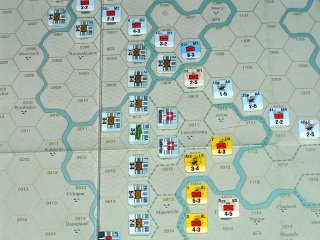Times being what they are (lacking time, that is), it’s only take me a week or so since it landed on my doorstep to get this one all ready to go. Which probably leads the casual observer (people without 15-month-olds running around the house switching all of the electronics off and on) to believe I’m some kind of a moron.
Physically, it’s not a large game. It’s packaged in one of APL’s small format boxes and retails for $20. 140 counters, small format rule book. The map, however, is more or less full-sized – and I’m going to address the subject of the map first because it’s my only real gripe with the game.
I say “more or less” full-sized because maybe a quarter of the map sheet is essentially waste area on the left-hand side. There’s a big honking title for the game – just in case you forget what you’re playing – and all of the game tracks are very small indeed. The terrain effects chart is not printed on the map. Perhaps it was supposed to be. In fact, the TEC is only available as a download from the APL web site.
The appreciation of map art, of course, is very subjective. Some folks like the Strange Defeat map, others don’t mind it. It’s not what I’d call a ‘bad’ map by any stretch. But it somewhat “underwhelming”, for lack of a better term.
It uses some of the same iconography found in the early games of the series – Defiant Russia and Red Vengeance. Small ‘sky scraper’ icons for major cities and a trio of ‘teepees’ for minor cities. Functional, but not much to crow about. Typography on the map looks rather small to me. There are no river names. The overall Michael Graves-ish blue and sepia pastel color scheme matches well with the box art, but gives the whole thing a bit too much distance and lacks impact.
From a function standpoint, my biggest gripe is with the very light cross-hatching used on the map to represent rough terrain, including the Ardennes. It is very light indeed and quite difficult for older eyes to discern – blue cross-hatching on a slightly lighter blue background. I also question how much of the huge expanse of map that lies west of Paris will come into play, although in fairness I have not yet played a complete and don’t have a feel for the campaign possibilities.
Counter artwork is up to the usual APL good standard, although they are nothing spectacular. This is due, in part, to the map color scheme. Blue-gray German units and French blue.. well, French … units lose their impact to a degree because of the blue map theme. Otherwise, they are quite readable and well done.
The hex-grid numbering, according to APL, was ‘flipped in production’. As a result, they have provided a new setup card as a download on their website. The setup listed in the rulebook, as a result of the ‘flip’, is completely useless. Oh, and one quick mention of the overall map orientation: The map’s ‘top’ is south in this game. North is at the bottom.
Setup takes a bit longer than you would think for such a small game. It probably gets quicker with experience. Units are each tagged with a setup code, and each setup code has an allowable range of hexes for deployment as listed on the setup card.
Here’s a digisnap of the deployments around the Ardennes used for my first game.

The Germans have basically three setup groups: One covering the Westwall defenses, one comprising the forces attacking out of the Ardennes and a third comprising the attackers from the Ardennes north.
Allied setup groups are more complicated. There are four smaller groups covering the Maginot Line. Another group screens France from the Maginot to the Belgian border. Netherlands and Belgian forces have their own deployment zones. The British, save for one unit, all deploy in or adjacent to Liege. And the French have a further general reserve that deploys within 4 hexes of Paris. A couple of other small deployment groups finish things out.
Next time: The first turn.

No comments:
Post a Comment